Design Thinking Process

Design Thinking: A User-Centered Approach to Innovation
Design Thinking is a human-centered approach to innovation that integrates the needs of people, the possibilities of technology, and the requirements for business success. The process involves the following key steps:
1. Empathize
The first step in the Design Thinking process is to understand the user's needs. This can be achieved through methods such as user interviews, observations, and immersion in the user's environment. The goal is to gain an empathetic understanding of the problem you are trying to solve.
2. Define
Once you've gathered a lot of information, you'll need to make sense of it. This involves identifying patterns, themes, and insights. This is often done through methods such as affinity mapping, persona creation, and problem statement framing. The goal of this stage is to define a clear problem statement that is human-centered.
3. Ideate
With a clear problem statement, you can start to generate ideas. Techniques such as brainstorming, mind mapping, sketching, SCAMPER (Substitute, Combine, Adapt, Modify, Put to another use, Eliminate, Reverse), and "How Might We" questions can be used. The goal is to generate a large quantity of ideas that you might solve your problem.
4. Prototype
This stage involves producing a number of inexpensive, scaled-down versions of the product or specific features found within the product, so you can investigate the problem solutions generated in the previous stage. Prototypes might be shared and tested within the team itself, in other departments, or on a small group of people outside the design team.
5. Test
In the testing phase, the solutions or prototypes are tested within the target group. The results generated during the testing phase are often used to redefine one or more problems and inform the understanding of the users, the conditions of use, how people think, behave, and feel, and to empathize.
Remember, Design Thinking is an iterative process, often cycles back to a previous stage for further investigation or exploration. It's not a linear process but rather a continuous loop of understanding, exploring, and learning.
In addition to these steps, it's important to foster a collaborative and open-minded environment, where all ideas are welcomed and everyone's perspectives are valued. This will help to ensure the success of your Design Thinking efforts.


Comments ()